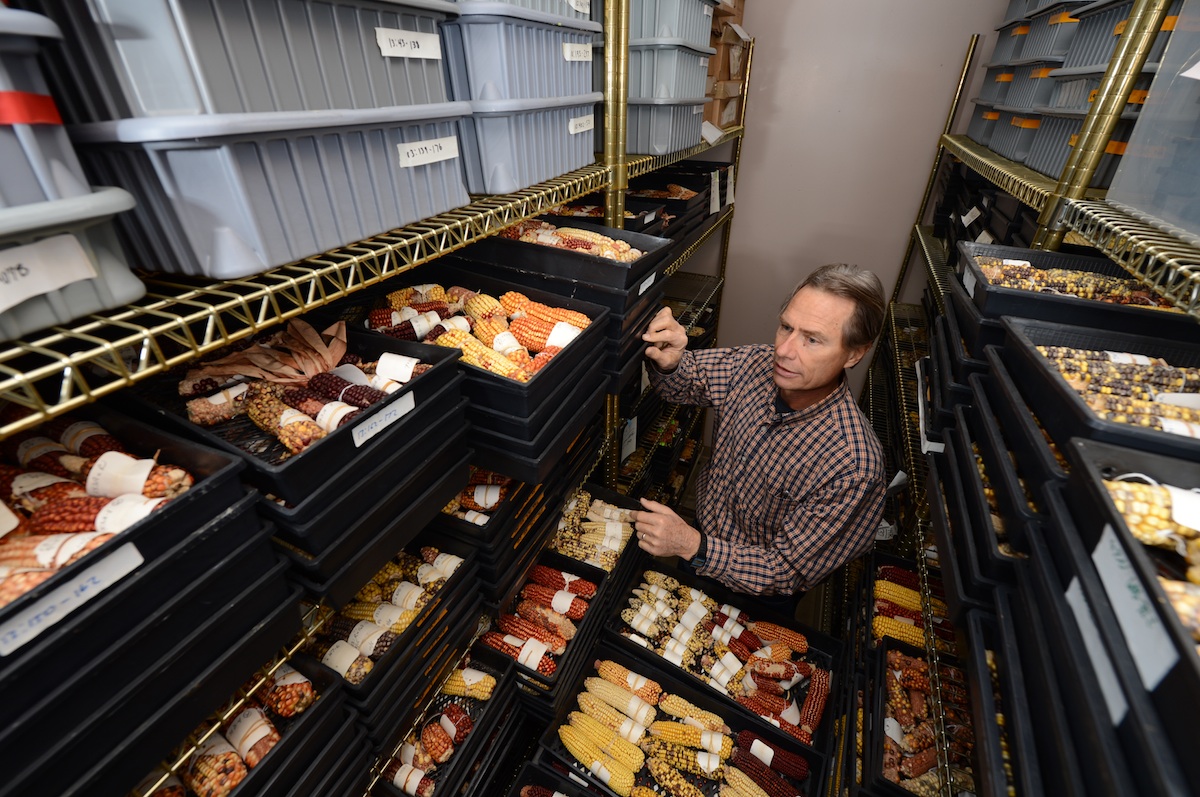
Nature’s Promiscuous Revisers: Transposable Elements
Thomas Peterson, a leader in transposon biology, does fundamental research that pulls him deep into the swoops, swishes and switches of the corn plant genome.
Sixty-four years ago transposable elements were discovered in maize. Thirty years ago a Nobel Prize was awarded to the scientist who found them. Three years ago, the maize genome map appeared in the pages of the journal Science, confirming that eighty-five percent of the maize genetic hard drive involves transposable elements, “transposons”.
DNA with wanderlust
Transposons are pieces of genetic material that freely and unpredictably caper around the genome. They can contain one gene or many genes, and regulatory elements—the so called junk DNA that scientists now know is anything but junk.
“This is the raw material for evolution,” says Thomas Peterson, Pioneer Chair in Maize Molecular Genetics and professor of genetics, development and cell biology.
Peterson was a graduate student when Barbara McClintock received her Nobel Prize in 1983. “At the time, it was so remarkable that this little piece of DNA could move around the chromosome when common wisdom stated that genes stayed in place,” he says.
In the intervening years, transposable elements have been found within the genomes of most organisms—from Arabidopsis to Homosapien to Xanthomonas.
Mother Nature’s genetic engineering
Plant breeding depends on natural variability recombined to create favorable types of plants. New molecular techniques for engineering DNA such as transcription activator-like effector nucleases (TALENs), that target specific sequences and cut the DNA, are making it possible to place genetic modifications where they are most likely to succeed.
But dramatic contributions to natural variability come from transposons. They are Mother Nature’s way of introducing variability—genomic complexity—genetically engineering on a large scale.
Peterson describes their behavior as somewhat like a computer in which the select, insert and delete functions sporadically activate to delete, move, copy and paste chunks of text all over a document. The resulting copy can accumulate duplicate sentences and paragraphs. At first these additions might seem irrelevant or disruptive, but over time some of the duplicate text morphs into prize-winning prose.
”People would like to control transposons but they have a reputation for being wild—if the TALENs approach is a smart bomb then the transposon system is an atom bomb,” says Peterson. “No one wants to unleash the transposon system into their carefully controlled genetic material but, the potential benefit transposons offer is that they open up so many kinds of large changes that are not feasible using any other method.”
Where the fine-tuning begins
About 50 percent of genes present in the maize genus are duplicates. Many sit side by side; others are peppered throughout the genome. Peterson studies relative activity rates and the mechanisms transposons employ to copy, slot in, slip out, or invert whole sections of DNA in maize. A transposon containing the maize gene for red kernel color allows Peterson to track its activity phenotypically (visually) through cob and kernel.
Transposon capering is enabled by an enzyme called transposase that frees the element with what Peterson believes is a clean cut to the DNA. Whether the transposon reinserts as a simple relocation or a large chromosomal rearrangement appears to be determined by the number of surrounding transposons and which end of a given transposon is cut and therefore activated.
Furthermore, environmental stresses such as heat and cold appear to encourage transposon-enabled gene duplication. Peterson’s current work proposes a new mechanism whereby endpoints of neighboring transposons contribute the scaffolding for rapid reprinting of side-by-side copies of a gene or its removal.
“Once you make two copies of a gene, one can change or adapt, developing a new function such as coding for a protein that recognizes a specific pathogen and confers disease resistance,” says Peterson. The other copy preserves the original function. Alternatively, deleting or disrupting a gene that has a negative effect on the organism can confer new advantage.



